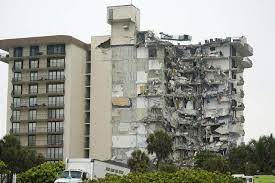 There is lots of blame to go around for the horrifying collapse of the Champlain Towers condominiums complex in Surfside, Florida, in June 2021:
There is lots of blame to go around for the horrifying collapse of the Champlain Towers condominiums complex in Surfside, Florida, in June 2021:
(1) Engineers’ reports on structural flaws in Champlain Towers could have been more forceful and explicit,
(2) Members of the Champlain Towers condo board could have been more attentive and willing to act regarding the dangerous conditions, and
(3) State and local governments could have made inspections earlier and warned that the residents of Champlain Towers of their vulnerability.
Add to the list of causes for the disaster the tenancy in common (TIC) and the modern-day attitudes about ownership of property that the TIC brings to the surface.
Many will recall from first-year Property that a TIC is a shared tenancy in which each owner has a separately transferable share of the property but may not claim ownership of a specific part of the property. All of the tenants in common are able to use the whole property. TICs emerged in early-modern England and were much treasured by the gentry as a way to consolidate family interests. Family bloodlines, after all, were often indistinguishable from family property lines.
A variety of the TIC has lived on into the contemporary United States and is common in what seems sometimes like our ubiquitous condominium complexes. Approximately one in five residential properties in the United States is a condo, and the number jumps to one in three in Miami and Fort Lauderdale areas.
In a standard condominium complex, each property holder owns an individual unit, but each property holder also has a non-exclusive right to use what are designated as common areas. This TIC would typically include hallways, elevators, decks, grounds, parking garages, and so forth.
Scholars have bemoaned the way individuals deplete the commons once they conclude nobody is prepared to work for the common good, but the problem in Champlain Towers was somewhat different. Residents were willing to invest in their 135 individual units but not in the common areas, especially after the condo board estimated that it would take $15 million in order to complete anticipated repairs.
The sentiment seemed to be that investment was unnecessary since the common areas were not really privately owned. Nobody cared a great deal about the TIC. In an era in which separate, private property ownership reigns supreme, the TIC registered as superfluous and even a burden. Some 98 lives were tragically lost in part because of an outdated legal construct and the attitudes regarding property that surrounded it.

That’s an interesting take, I don’t know if I’ve ever heard anybody argue condo owners don’t care about the common areas. What form of ownership would you suggest instead? I don’t think joint tenancy would address the problem you suggest. Neither would a separate legal entity with each condo owner having an ownership share. I guess you would rather it just be more like a rental with a separate landlord who owns the common areas?
I think condo owners may care about the common areas, but as the tragedy in Surfside showed, they don’t care enough about the common areas to invest in them. Investment went almost completely to individual privately-owned units.
One alternative could be the coop, in which people own shares of a single entity and have rights to live in particular units. They are common in NYC, and I notice that one was just set up in Riverwest in Milwaukee.